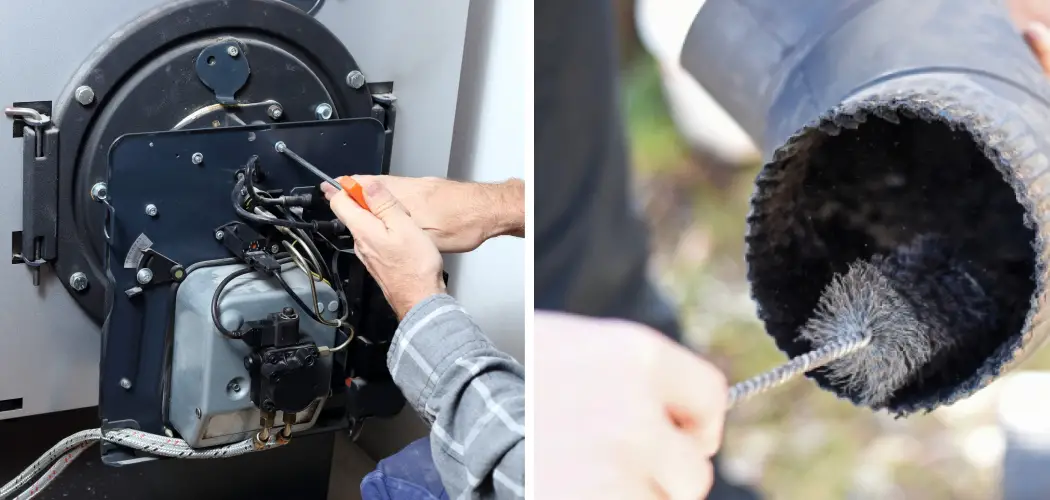Are you feeling cold in your home? That could be because your oil furnace is not functioning properly. An oil furnace requires regular cleaning and maintenance to ensure it works efficiently and effectively, especially during winter when it is used more often.
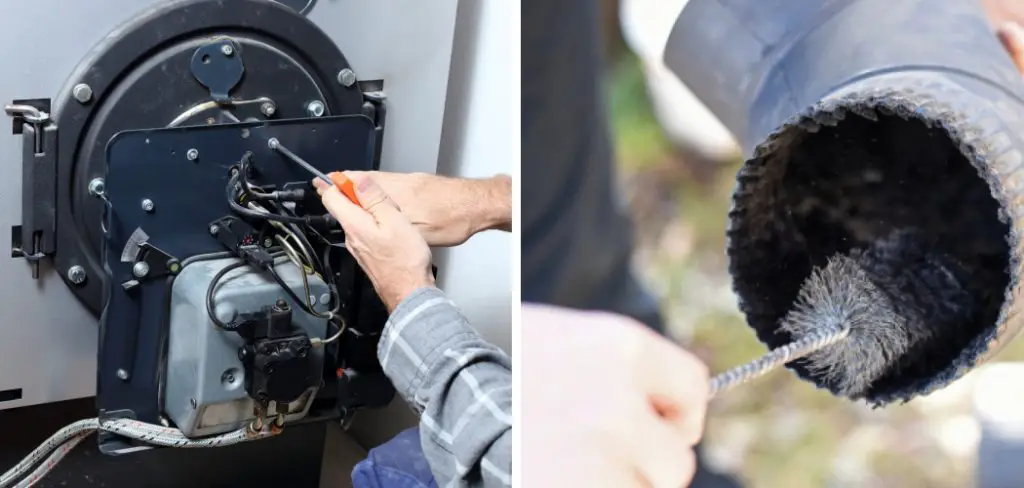
Maintaining an oil furnace is critical to ensuring the efficiency and longevity of your heating system, especially in areas that experience harsh winters. Cleaning your oil furnace not only enhances its performance but also prevents potential safety hazards, such as fires caused by clogged vents or a build-up of dirt and soot. This guide on how to clean a oil furnace, aims to introduce homeowners to the essential steps involved in cleaning an oil furnace.
By following a straightforward and methodical approach, even those with minimal mechanical experience can effectively clean their system, ensuring it runs smoothly and efficiently throughout the colder months.
What are the Benefits of Cleaning an Oil Furnace?
Cleaning your oil furnace has various benefits, including:
- Improved Efficiency: A clean furnace runs more efficiently and uses less energy to produce the same amount of heat.
- Cost Savings: With improved efficiency, a clean furnace can save you money on your heating bills.
- Extended Lifespan: Regular cleaning and maintenance can extend your oil furnace’s lifespan, saving you from costly replacements.
- Improved Air Quality: Dust and debris build-up in your furnace can circulate in the air, resulting in poor indoor air quality. By regularly cleaning your furnace, you can improve the air quality in your home.
- Prevention of Potential Hazards: Regular cleaning prevents potential safety hazards such as fires caused by a build-up of dirt, debris, and soot in the furnace.
These benefits make cleaning your oil furnace an essential task for any homeowner.
What You Will Need
Gathering all the necessary tools and materials before starting the cleaning process will ensure a smooth and efficient cleaning experience. Some of the essential items you will need are:
- Protective Gear: To protect yourself from any potential hazards, wear protective gear such as gloves, safety glasses, and a mask.
- A Vacuum Cleaner: A powerful vacuum with a long hose is necessary for removing dust and debris from the furnace.
- Cleaning Brushes: Different sizes of cleaning brushes will be needed to thoroughly clean different parts of the furnace.
- Rags and Towels: These can be used to wipe down surfaces and absorb any excess oil or debris during cleaning.
Once you have all the necessary items, you are ready to start cleaning your oil furnace.
10 Easy Steps on How to Clean a Oil Furnace
Step 1. Turn off the Power and Fuel Supply:
Before starting the cleaning process, it’s imperative to ensure your safety by turning off the power to the furnace at the main switch or breaker box. Additionally, turn off the fuel supply to prevent any accidents. This step helps in creating a safe working environment.
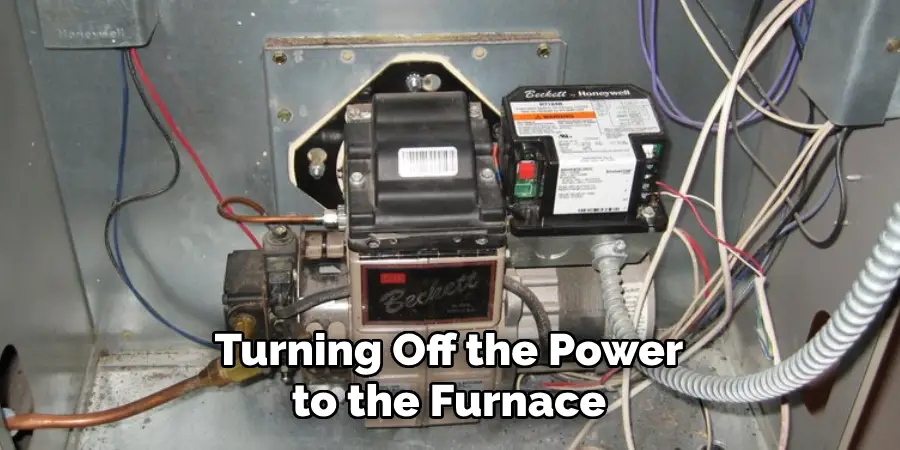
Step 2. Remove the Access Panels:
Remove the access panels from the furnace once the power and fuel supply are securely turned off. Depending on your furnace model, this step might require a screwdriver or another tool. Removing the panels will grant you access to the interior components of the furnace, such as the filter, blower, and motor, making it easier to conduct a thorough cleaning.
Step 3. Clean or Replace the Filter:
The filter in your oil furnace plays a crucial role in maintaining air quality by trapping dust, debris, and other airborne particles. Start by locating the filter, which is typically found in the intake or blower compartment. Sift through it; if the filter appears clogged or significantly dirty, it’s best to replace it with a new one.
However, if your furnace uses a reusable filter, you can clean it according to the manufacturer’s instructions, usually involving a gentle rinse with water. Remember, a clean filter not only improves air quality but also enhances the efficiency of your furnace.
Step 4. Vacuum the Interior Components:
With the access panels removed and the filter cleaned or replaced, the next step involves vacuuming the interior components of the furnace. Utilize a powerful vacuum cleaner with a long hose to reach inside the furnace.
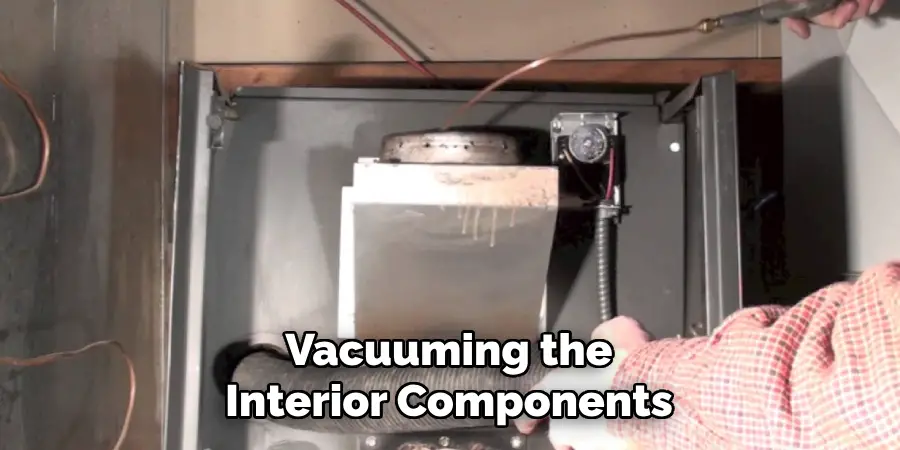
Focus on areas where dust and debris tend to accumulate, such as the blower blades, the motor, and around the burners. It’s important to do this gently to avoid damaging any delicate components. This step is crucial for removing loose soot, dust, and debris, which can hinder the furnace’s efficiency and potentially pose a fire hazard if left unattended.
Step 5. Clean the Burners:
The burners are a critical part of your oil furnace, responsible for mixing oil with air and igniting the mixture to generate heat. With time, these can become clogged with soot and debris, affecting the furnace’s efficiency and safety. Carefully remove the burners, following the manufacturer’s instructions if necessary. Use a small brush or cloth to gently clean any visible dirt or soot from the burners.
For tougher deposits, a vacuum cleaner can be used to suck out debris from hard-to-reach areas. After cleaning, make sure the burners are dry and free of any cleaning residue before re-installing them. Proper maintenance of the burners ensures optimal performance and minimizes the risk of fire hazards.
Step 6. Inspect and Clean the Chimney and Vent System:
The chimney and vent system play a crucial role in safely removing the combustion gases produced by your oil furnace. Over time, these passages can become blocked with soot or debris, leading to inefficient furnace operation and potential safety risks. Begin this step by inspecting the chimney and venting system for any blockages or corrosion.
If accessible, use a chimney brush to clean the inside of the chimney flue and vent pipes. Make sure to wear protective gear to avoid inhaling any soot or debris. This step ensures the safe operation of your furnace and helps maintain an efficient heating system.
Step 7. Check and Lubricate the Blower Motor and Bearings:
After cleaning the burners and inspecting the chimney and vent system, the next step focuses on the blower motor and bearings, which are essential for circulating hot air throughout your home. Check the blower motor and bearings for any signs of wear or damage.
If your furnace’s blower motor is equipped with lubrication ports, apply two to three drops of machine oil in each port. Be careful not to over-lubricate. If the bearings are sealed, they do not require lubrication. This step ensures that the blower motor operates smoothly, improving the overall efficiency of your oil furnace.
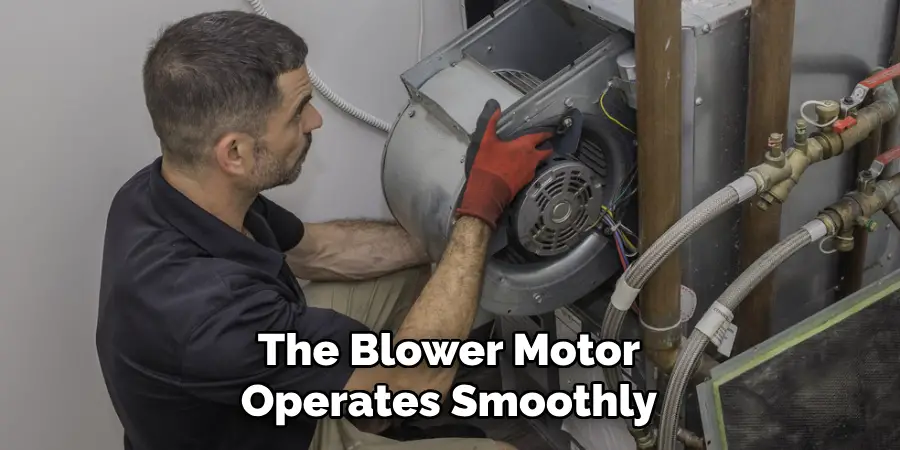
Step 8. Reassemble and Test Your Furnace:
Once you’ve completed the cleaning and maintenance tasks, it’s time to reassemble your furnace. Carefully replace the burners, ensuring they are securely fitted. Reattach the access panels and make sure they are tightly screwed in. Now, turn the power and fuel supply back on. Start your furnace and observe if it operates smoothly.
Listen for any unusual noises and check for proper flame in the burner and the presence of any smoke indicating incomplete combustion. This step is crucial for verifying that the furnace is functioning correctly and safely after maintenance.
Step 9. Check the Thermostat and Controls:
After confirming that your furnace is operating correctly, the next step involves checking the thermostat and other controls. Ensure the thermostat is accurately measuring the indoor temperature and responding to adjustments. Test the responsiveness by changing the temperature setting and observing if the furnace and the blower react accordingly.
Also, inspect any safety switches and controls to ensure they are functioning correctly. This step is vital for achieving optimal comfort and efficiency, as well as preventing any potential safety issues due to malfunctioning controls.
Step 10. Schedule Regular Maintenance Checks:
The final step in maintaining your oil furnace involves planning for future upkeep. Schedule regular maintenance checks at least once a year, preferably before the heating season begins. Professional HVAC technicians can perform comprehensive evaluations, including checks on parts that are difficult for homeowners to access.
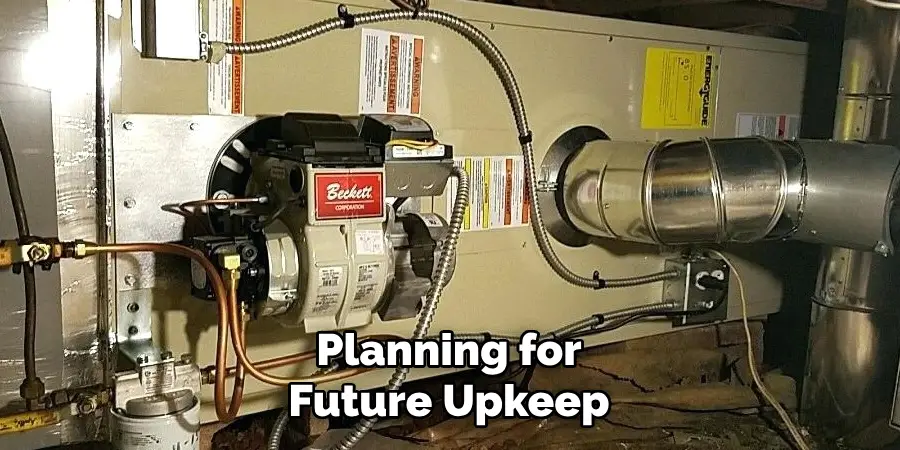
Regular professional maintenance helps in identifying potential issues before they become serious, ensuring the longevity and efficiency of your furnace. Preventative maintenance is key to avoiding unexpected breakdowns and keeping your heating system running smoothly throughout the colder months.
By following these ten steps, you can ensure the optimal functioning of your oil furnace, improving its efficiency and lifespan while also prioritizing safety for you and your family.
5 Additional Tips and Tricks
- Prioritize Safety: Before starting any cleaning process, ensure that the furnace is completely shut off and cooled down. Wear protective gear such as gloves and eye protection to avoid contact with potentially harmful chemicals or debris.
- Use the Right Tools: Having the correct tools on hand can make the cleaning process more efficient. This includes a high-quality vacuum cleaner for dust and soot, soft cloths for wiping down surfaces, and a wire brush for scrubbing away stubborn deposits.
- Check the Chimney and Vent: The chimney and vent can accumulate soot and blockages that impair the furnace’s efficiency. Inspect these areas regularly and clear any obstructions to ensure proper ventilation and operation of your oil furnace.
- Replace Filters Regularly: One of the simplest yet most effective maintenance tasks is regularly replacing your furnace’s oil and air filters. Clean filters improve your furnace’s efficiency and the quality of air circulated throughout your home.
- Schedule Professional Maintenance: While DIY cleaning and maintenance are important, having your oil furnace professionally serviced at least once a year is crucial. A professional can perform a thorough cleaning, inspect for issues, and make necessary adjustments to ensure your furnace operates safely and efficiently.
With these additional tips and tricks, you can keep your oil furnace running smoothly and efficiently for years to come.
5 Things You Should Avoid
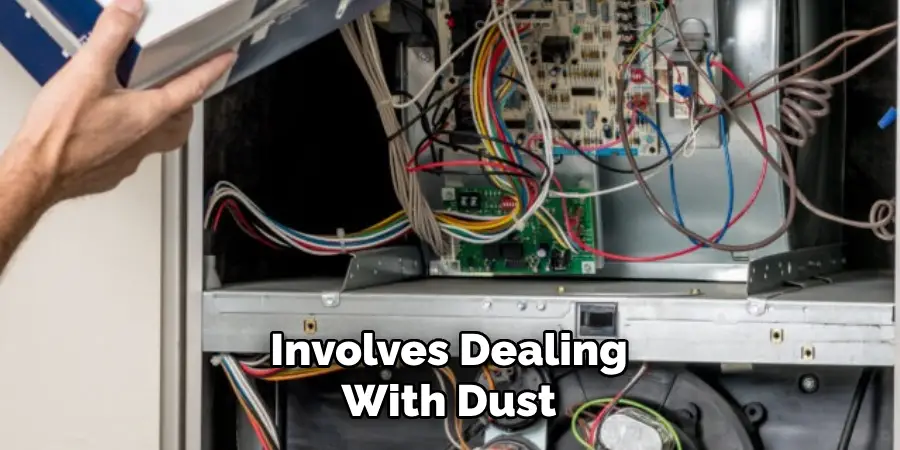
- Ignoring Manufacturer’s Instructions: Every furnace is different, and disregarding the manufacturer’s guidelines can lead to improper maintenance methods, potentially damaging your unit or voiding your warranty.
- Using Harsh Chemical Cleaners: Harsh chemicals can damage the internal components of your furnace. Stick to recommended cleaners and avoid substances that could corrode metal parts or harm wiring.
- Skipping Protective Gear: Cleaning a furnace involves dealing with dust, debris, and possibly sharp edges. Always wear protective gloves, eyewear, and a mask to avoid injuries and inhale less dust.
- Neglecting to Disconnect Power: Before beginning any cleaning or maintenance work, ensure the power supply to the furnace is completely disconnected. This prevents the risk of electric shock or the furnace accidentally turning on during cleaning.
- Forcing Components Apart: If you encounter parts that are difficult to remove or reassemble, don’t force them. Forcing components can break them or misalign your furnace, leading to inefficient operation or the need for costly repairs.
By avoiding these common mistakes, you can safely and effectively clean your oil furnace without causing any damage or harm.
What are the Causes of Furnace Issues?
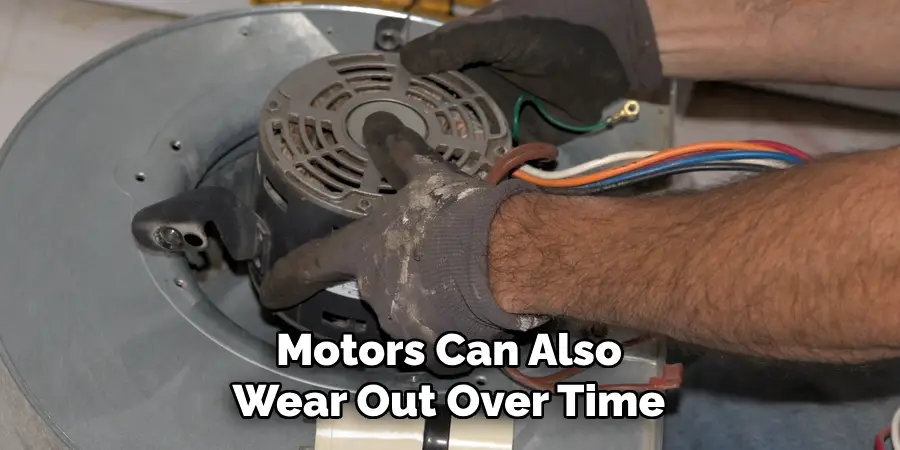
Furnaces can experience issues for various reasons, including lack of maintenance, wear and tear, and improper installation. Refrain from regular cleaning and maintenance tasks to avoid buildup of dust, debris, and soot inside the furnace, leading to clogs and reduced efficiency.
Components such as belts, bearings, and motors can also wear out over time, causing issues. To ensure the furnace operates smoothly, these parts may need to be replaced periodically.
Improper installation can also contribute to furnace problems. If the unit is not installed correctly, it may not operate efficiently or safely, leading to potential breakdowns and safety hazards.
Regular maintenance, proper installation, and careful attention to warning signs can help prevent or address any potential issues with your oil furnace. By taking good care of your furnace, you can keep it running smoothly and efficiently for years to come.
What Are the Disadvantages of Not Cleaning Your Oil Furnace?
- Reduced Efficiency: One of the main disadvantages of not cleaning your oil furnace is reduced efficiency. The buildup of dust and debris can clog filters, impede airflow, and reduce the furnace’s ability to heat your home effectively.
- Increased Energy Costs: A dirty or clogged furnace must work harder to produce the same heat, resulting in higher energy bills. Regular cleaning and maintenance can keep your furnace running efficiently and save you money on energy costs.
- Potential Safety Hazards: A buildup of soot, debris, or blockages in the furnace can lead to safety hazards such as carbon monoxide leaks or fires. Proper cleaning can reduce these risks and ensure the safe operation of your furnace.
- Shorter Lifespan: Neglecting to clean and maintain your oil furnace can lead to premature wear and tear on components, reducing the unit’s overall lifespan. Regular cleaning can help extend the life of your furnace and save you money on costly repairs or replacements.
- Decreased Air Quality: A dirty furnace can circulate dust, allergens, and other pollutants throughout your home. Regular cleaning and maintenance can help improve the air quality in your home and reduce potential health risks.
It is important to prioritize regular cleaning and maintenance of your oil furnace to avoid these disadvantages and ensure your heating system’s safe and efficient operation.
How Can You Make Solution Cleaning More Environmentally Friendly?
- Use Eco-Friendly Cleaners: When cleaning your oil furnace, use environmentally friendly cleaning products that are biodegradable and non-toxic. These products are better for the environment and can also be safer for you to handle.
- Proper Disposal of Waste: Make sure to dispose of any waste or materials from cleaning your furnace properly. This includes used filters, old oil, and any other debris. Do not pour oil or chemicals into drains or sewers.
- Consider Renewable Energy Sources: Consider upgrading to a more environmentally friendly heating system that uses renewable energy sources such as solar power or geothermal heat pumps. These systems can reduce your home’s carbon footprint and save you money on energy costs in the long run.
- Schedule Regular Maintenance: By keeping your furnace clean and well-maintained, you can prevent larger issues that may require harsher cleaning solutions or even replacement of the unit. Regular maintenance can also help improve your furnace’s overall efficiency, reducing its impact on the environment.
- Educate Yourself and Others: Learn about environmentally friendly cleaning methods and share your knowledge with others. By educating yourself and those around you, you can positively impact the environment and encourage others to do the same.
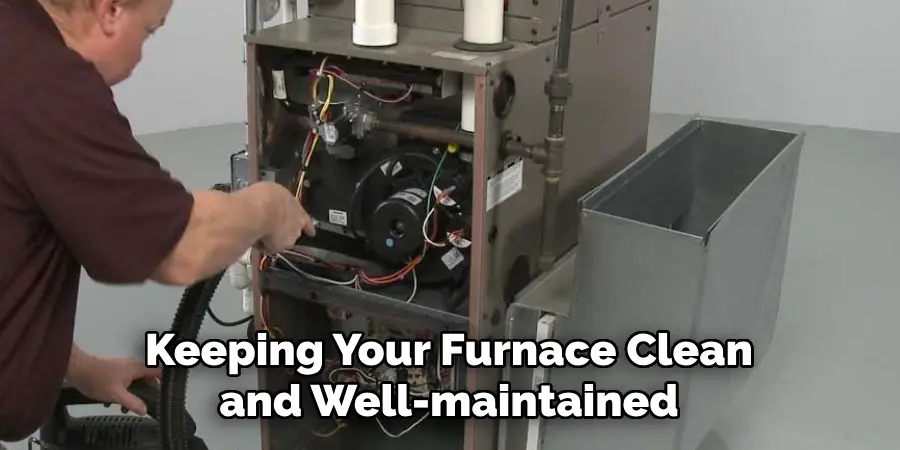
By implementing these practices, you can make solution cleaning of your oil furnace more environmentally friendly and contribute to a cleaner, healthier planet.
Conclusion
How to clean a oil furnace is an essential maintenance task that not only ensures the efficient operation of your heating system but also extends its lifespan and maintains indoor air quality.
Homeowners can safely and effectively maintain their oil furnaces by following the recommended cleaning procedures, using the correct tools and solutions, and avoiding common mistakes. It’s important to incorporate eco-friendly practices into this maintenance to not only protect your home environment but also contribute to global sustainability efforts.
Regular, proactive cleaning and maintenance of your oil furnace can result in significant energy savings, reduced repair costs, and a more comfortable, safe living environment.
Always remember, if a task seems beyond your skill level or if you encounter significant issues during maintenance, seeking professional help is the best course of action to ensure the safety and efficiency of your furnace.

